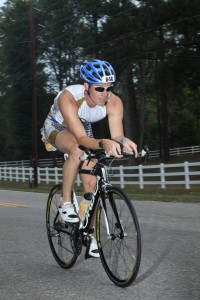The second discipline of every triathlon, the bike, differs in a very important way from the  swim and the run: your performance depends a great deal not just on your body, but on your equipment. I’m going to try to narrow down some of the choices for you in this blog post, and offer you some beginner triathlon bike tips that will get you out on the road safely, economically, and most importantly, help you get from the swim to the run in the shortest amount of time possible! Of course equipment plays a role in swimming and running too. Your wetsuit or swim skin can have a significant impact on your times in the water, and getting the right running shoes and clothing is essential to a superlative run split. But nowhere else will your choices of equipment have quite the same impact on your race as they will on the bike. So what equipment will you need to get started?
swim and the run: your performance depends a great deal not just on your body, but on your equipment. I’m going to try to narrow down some of the choices for you in this blog post, and offer you some beginner triathlon bike tips that will get you out on the road safely, economically, and most importantly, help you get from the swim to the run in the shortest amount of time possible! Of course equipment plays a role in swimming and running too. Your wetsuit or swim skin can have a significant impact on your times in the water, and getting the right running shoes and clothing is essential to a superlative run split. But nowhere else will your choices of equipment have quite the same impact on your race as they will on the bike. So what equipment will you need to get started?
Triathlon Tip #1: The Bike. Of course, the most important piece of equipment that you are going to need is a bike. That much is obvious, but deciding on which bike for you is not so easy. There is an absolutely astounding array of bike equipment out there, and you probably already know that most of is also astoundingly expensive. I bought my first triathlon bike right after I graduated from college. Up until then, I’d gotten by borrowing rides from friends and friends of friends. But after graduation, I took every bit of money I had (including the money my parents gave me for a class ring) and headed down to the local bike shop and told them I needed a bike, pedals, and a new pair of cycling shoes. I was completely broke, but I could ride! So this raises one of the most important issues when shopping for a bike: money. You can easily spend $10,000 or more on a carbon fiber time machine these days, but there are a lot of decent bikes that start at about $1500. Less than that, and you’re going to get something that will provide you with more frustration than pleasure. When you start spending above $3000, you’re getting into pretty diminishing returns. My triathlon bike tip is to stick to the $1500-$3000 price range. You’ll get all the bike you need without having to take a second mortgage or sell a kidney. Don’t forget that the most important part of the bike is the engine: You! However, you and your bike will be spending a lot of time together, so do some research, make sure your bike fits, and pick the right one.
Triathlon Tip #2: The Helmet. Without a doubt, the second most important piece of triathlon bike equipment that you can buy is a good helmet. This is a major safety issue, so don’t go cheap! My most important triathlon bike tip is to get a good helmet, and wear it every single time you get on your bike. This is an issue I take seriously. When I was eight years old I spent New Year’s Eve waiting on news about my sister from the emergency room after she’d fallen from a horse and fractured her skull. She spent a couple of days in a coma, but thankfully made a full recovery. Many people with head injuries aren’t so lucky, so even if you like the feeling of the hair blowing in the wind as you fly down the road, you’re going to need to get used to that helmet.
Triathlon Tip #3: Sunglasses. They’re not just about looking cool! Sunglasses help block the glare of the sun, and also debris that you’ll encounter on the road. You’ll find out just how much dust, dirt, and pollen there are in the air during a long ride without eye protection, so get some decent shades and save some wear and tear on your eyes. You may even look a little cooler on the bike, and the road will definitely look a lot cooler from your bike. Just remember one simple rule: if you get some over the top Mario Cippolini-Style Italian rock star glasses, save them for the bike. Unless you happen to actually be an Italian cycling super star, the further you get from your bike, the bigger the geek you’re going to look like. Same rule applies to bike shorts.
Triathlon Tip #4: Shoes and Pedals. If you’re getting serious about cycling, you’re going to need to invest in a good pair of clipless pedals and cycling shoes. Somewhat confusingly, “clipless” pedals actually refer to the kind of pedals that your feet actually attach to, like with ski bindings. Before clipless pedals, cycling pedals had straps that ran over the tops of the athletes shoes and attached their feet to the pedals. The straps were called “toe clips”, hence shoes without these straps became known as “clipless”. These days hardly anyone ever rides with toe clips, so when you talk about pedals, cyclists will understand that you’re talking about clipless pedals. There is a definite advantage to being able to attach your feet to the pedals, that way you can apply pressure to the pedels through 360 degrees of the pedal stroke, not just as you’re pressing down. They’re not cheap, but if you’re serious about cycling they’re the only way to go.
Triathlon Tip #5: GPS/Bike Computer: Once you start logging some miles on the bike, you’re going to want to be able to track your progress. You’ll want to know how far you’ve ridden, what your average speed was, and how long your ride took you, at the very least! I still remember when I was about 13, one of my friends got a bike computer and we all thought it was the coolest thing ever. I grew up out in the country, so whenever I got together with friends we usually ended up running, hiking through the woods, or riding bikes. Once we got a computer to use, every weekend became a new challenge. If we rode 30 miles one weekend, we had to ride 35 the next. We got up to 50 mile rides, fueled by Coke and Snickers bars from the gas stations we passed. And that was riding an old steel mountain bike that weighed about 35 pounds! We had some great times though, and the lesson I learned from that was that tracking your training and constantly challenging yourself keeps things fun and interesting. Tracking your training and recording your progress gives you constant motivation to get out the door to train, and the best way to measure your performance on the bike is getting a good cycling computer. The new GPS options are more expensive, but work great and will most often enable you to upload workout data to your computer so that you can track it with a program like TrainingPeaks.
Triathlon Tip #6: Comfortable Cycling Clothes: Notice I didn’t say “expensive cycling clothes”! As with anything in triathlon, you can spend a fortune on clothes for the bike, a top of the line pair of cycling shorts can run well over $200 these days. If you don’t happen to have a couple of grand lying around that you’re just dying to spend on looking awesome on the bike, don’t despair. You can get plenty of good, functional clothes without spending a fortune. The first pair of cycling shorts I got was also the cheapest pair, and I can still wear them. They’ve outlasted many other pairs of shorts that cost twice as much. And besides, the most important thing is how fast you ride the bike, not the labels on your clothes, you hardly need to read triathlon bike tips to know that! But getting some decent cycling clothing for a variety of weather condition will make your rides much more comfortable and enjoyable, and if you shop smart it won’t break the bank.
Please visit ironworksmultisport.com again soon for more free triathlon tips, workouts, and information. Thanks for reading!




